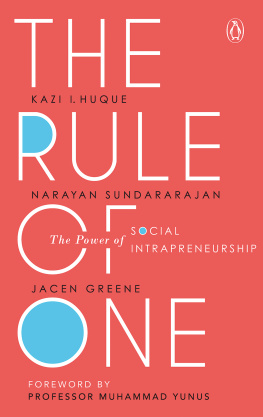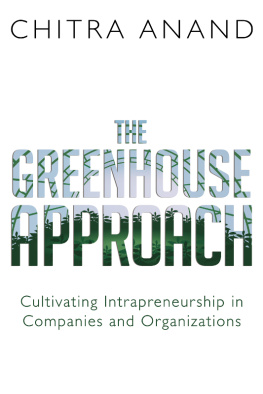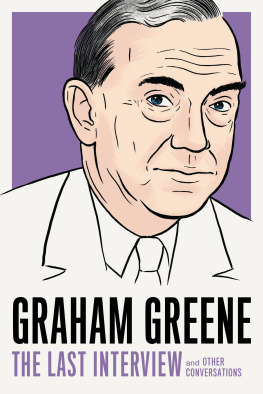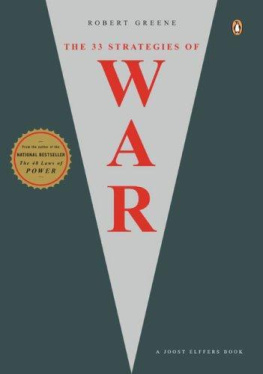Jacen Greene - The rule of one : the power of social intrapreneurship
Here you can read online Jacen Greene - The rule of one : the power of social intrapreneurship full text of the book (entire story) in english for free. Download pdf and epub, get meaning, cover and reviews about this ebook. year: 2019, publisher: Penguin Random House India Private Limited, genre: Politics. Description of the work, (preface) as well as reviews are available. Best literature library LitArk.com created for fans of good reading and offers a wide selection of genres:
Romance novel
Science fiction
Adventure
Detective
Science
History
Home and family
Prose
Art
Politics
Computer
Non-fiction
Religion
Business
Children
Humor
Choose a favorite category and find really read worthwhile books. Enjoy immersion in the world of imagination, feel the emotions of the characters or learn something new for yourself, make an fascinating discovery.
- Book:The rule of one : the power of social intrapreneurship
- Author:
- Publisher:Penguin Random House India Private Limited
- Genre:
- Year:2019
- Rating:4 / 5
- Favourites:Add to favourites
- Your mark:
- 80
- 1
- 2
- 3
- 4
- 5
The rule of one : the power of social intrapreneurship: summary, description and annotation
We offer to read an annotation, description, summary or preface (depends on what the author of the book "The rule of one : the power of social intrapreneurship" wrote himself). If you haven't found the necessary information about the book — write in the comments, we will try to find it.
Jacen Greene: author's other books
Who wrote The rule of one : the power of social intrapreneurship? Find out the surname, the name of the author of the book and a list of all author's works by series.
The rule of one : the power of social intrapreneurship — read online for free the complete book (whole text) full work
Below is the text of the book, divided by pages. System saving the place of the last page read, allows you to conveniently read the book "The rule of one : the power of social intrapreneurship" online for free, without having to search again every time where you left off. Put a bookmark, and you can go to the page where you finished reading at any time.
Font size:
Interval:
Bookmark:




PENGUIN BOOKS

PENGUIN BOOKS
The authors provide an engaging narrative of their incredible experiential learning as they went on to demonstrate the power of social intrapreneurship. Their shared learnings have led to an invaluable guidebook that is fascinating and very timely! A must-read.
R.A. Mashelkar, Padma Vibushan; national research professor; former director general, CSIR; president, Indian National Science Academy; chairman, National Innovation Foundation
We need to find ways to create opportunities for people to unleash their unlimited creative powers to overcome the barriers imposed by our flawed economic thinking. This book provides an example for aspiring entrepreneurs of a social business that uses technology to do just that.
MUHAMMAD YUNUS, Noble Peace Prize winner and author of The World of Three Zeros
This book is an essential guide for anyone interested in how a modern corporation used intrapreneurship and social innovation to affect lasting change for people in impoverished areas of the world. Students and professionals alike will be inspired by what can be accomplished when new approaches are embraced.
SANDRA MORRIS, former CIO, Intel Corporation
T echnology will keep on changing the world. There is nothing new about it. It has been happening since human beings have inhabited this planet. Technology is changing faster and faster. Where it took a century for change to happen, it takes a decade now. Soon it will be done in a day or less. But the big question is: What direction will this change be directed at? It can create a world of three zeroszero poverty, zero unemployment, zero net carbon emissionany time it wants. But are we directing the technology that way. Technology has the power to take us anywhere we want to go. But where do we want to go? Have we decided that?
When I founded Grameen Bank, I wanted to find a way to provide credit to those who needed it the most, but were turned away by the traditional banks. Through our work over the years, we have established the fact that it can be done in a financially sustainable way anywhere in the world. Again the question is: Are we willing to do it? It is no longer a question of whether it can be done.
Utilizing information technology and having it play a bigger role in addressing poverty was a key and an important next step, and former Intel CEO Craig Barrett and I saw an opportunity to bring technology to other fields which do not get much attention from the technology world. In doing so I soon met Kazi Huque and, later, Narayan Sundararajan, from Intel USA. They saw the possibilities to use the power of technology to ensure that people at the bottom have the same access to information technology as those at the top. Over the years, they became true entrepreneurs within a large corporation. Grameen Intel got started on a small scale with the same energy as a Silicon Valley start-up. The venture continues to inspire the creation of new gadgets, new software and, one day, hopefully, new chips.
This is a practitioners guide that shares some of the lessons they learned along the way. Forming a social business was only the beginning. Both Kazi and Narayan, along with Jacen Greene, touch upon the challenges they faced and the ways they went about tackling those. They outline how they brought business, technology and research expertise to address a host of issues in healthcare, education and agriculture.
Through the various chapters, the reader will benefit from learning ground-level realities. The authors have shared their experiences very candidly. They have covered areas where they have been successful, as well as what they would have done differently. The creative approach they outlined in the book can be used by any foundation, social business and development agency.
I hope more individuals will step up to become social business entrepreneurs, intrapreneurs in a large corporation, or part of a social business start-up. Individually or as part of a corporation interested in playing a direct role in changing the world, we can overcome many of the problems faced by society today. What is needed is a dedicated and focused effort towards those goals through a business format which doesnt distract it by imposing the mission of making profits for the shareholders of the company.
Professor Muhammad Yunus
Founder of Grameen Bank
Nobel Peace Prize Laureate, 2006
T ake out a world map and a pencil. Draw a circle with the centre in Bangladesh and a radius of 1500 miles. The circle covers much of India, Pakistan, China and Indonesia, some of the most densely populated countries in the world. There are more people living inside this circle than outside it, and many of them live in poverty (Quah, 2016).
When people think of economic development in developing countries, they often think of handouts: direct charity, development aid and low-cost loans provided to local governments. However, at the end of the day, the real solution to poverty is economic opportunity through education and jobs. We have seen information technology become a key economic driver in the West. We have seen outsourcing add millions of jobs in India. We have seen banks and microcredit institutions evolve to provide access to credit for the poor. Can we do more to create viable economic solutions using information technology for the impoverished parts of the world?
Efforts in this area thus far have centred on cheap devices, such as a $100 computer and greater broadband internet access, sometimes coupled with additional services. A typical approach is to donate computers to schools and hospitals, or to set up an Internet-enabled service centre in a remote village. The service centre comes with a promise to serve the low-income community by providing, for example, harvest information, or by processing online forms for land registries that help establish ownership claims. These efforts have only generated limited success in alleviating poverty, because more is needed than just setting up a computer with an internet connection. Entire government bureaucracies and organizations have to be created or redesigned to process this information to produce the required output. But more importantly, there has to be clear cash flow for the beneficiarybetter agricultural information leads to more income, or the ability to process a land registry leads to lower costs. Our approach to information technology adoption is ineffectual without those clear economic benefits.
In 2007, Craig Barrett was the chairman of Intel Corporation. He had previously served as CEO, and in his new role he acted as a technology ambassador travelling the world. In each country he visited, he met with the leaders of the government and major corporations. He talked about the impact of technology on education and healthcare, and he talked about how countries can catalyse their economic growth through the increased adoption of technology. On one of these trips, he met Muhammad Yunus, who had recently received the Nobel Peace Prize for his work on microcredit. Yunus shared the prize with Grameen Bank, which he had established to loan small amounts of money to those in poverty for income-generating purposes, enabling millions of people to alleviate their poverty by establishing access to financial credit.
Font size:
Interval:
Bookmark:
Similar books «The rule of one : the power of social intrapreneurship»
Look at similar books to The rule of one : the power of social intrapreneurship. We have selected literature similar in name and meaning in the hope of providing readers with more options to find new, interesting, not yet read works.
Discussion, reviews of the book The rule of one : the power of social intrapreneurship and just readers' own opinions. Leave your comments, write what you think about the work, its meaning or the main characters. Specify what exactly you liked and what you didn't like, and why you think so.












